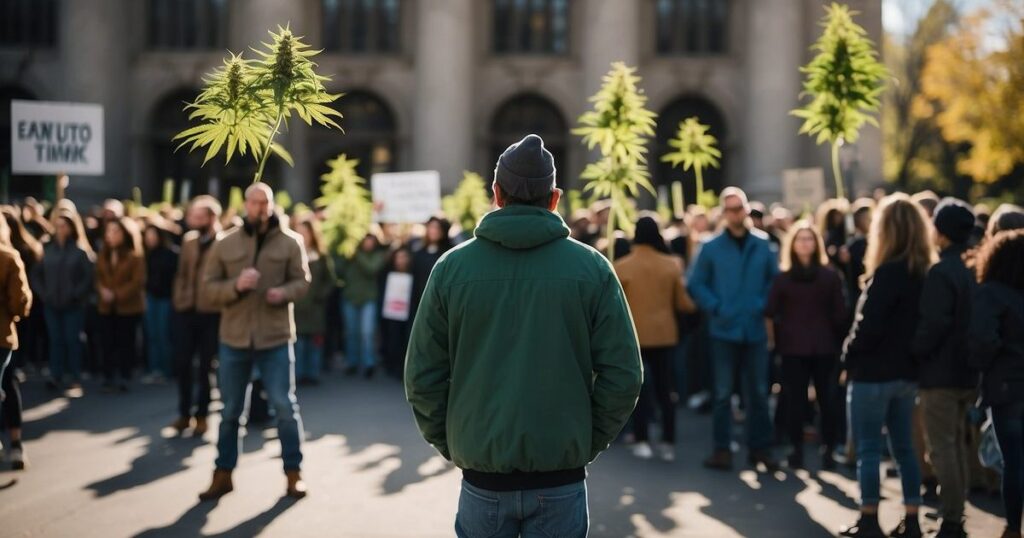Advocacy for Cannabis Legalization: The Case for Reform and Regulation
As the movement for cannabis legalization gains momentum across the United States, advocacy groups play a pivotal role in shifting public opinion and influencing legislative action. Organizations such as Americans for Safe Access and the Marijuana Justice Coalition have been instrumental in advancing the conversation about cannabis away from prohibition and towards a regulated, legal market. They center their efforts on education, support for medical patients, guidance for the industry, and promoting reform through a justice lens.
Furthermore, the changing legislative landscape reflects a growing acknowledgment of both the potential benefits and the complexities tied to cannabis legalization. Recently, states like Ohio have moved to legalize cannabis for adult use, demonstrating a shift in public sentiment and responding to the advocacy work conducted on the ground. Also, these policy changes also respond to the evolving understanding of cannabis’s impact on public health and the criminal justice system, aiming to establish a regulatory framework that addresses both.
Key Takeaways
- Advocacy groups are crucial in the push for legal cannabis reform.
- Legalization efforts reflect changing laws and public opinion in the United States.
- Implications on health and criminal justice influence cannabis policy reform.
Legislative Landscape and Public Sentiment
Your understanding of the advocacy for cannabis legalization must consider the intricate relationship between legislative actions, public opinion, and the drive for social equity. Additionally, this section dissects the current legal framework, assesses public sentiment, and examines how criminal justice reform intertwines with the campaign for legalization.
Current Legal Status and Federal Context
The Controlled Substances Act currently classifies marijuana as a Schedule I drug, indicating a high potential for abuse and no accepted medical use. Nonetheless, your observation would reveal a patchwork of state laws: many states have moved to legalize or decriminalize cannabis, either for medical or recreational use. Notably, steps by governors and the Senate to reassess these federal classifications reflect the ongoing advocacy efforts and growing support for policy change.
Public Opinion and Voter Initiatives
Public support for the legalization of cannabis has shown a significant upward trajectory. With 66 percent approval as of 2019, the numbers underscore the transformation in societal attitudes. In addition, voters have been instrumental in this shift, approving ballot initiatives in various states and bypassing legislative roadblocks. This momentum fuels advocacy groups, such as the Drug Policy Alliance, to intensify their efforts at both state and federal levels.
Criminal Justice Reform and Social Equity
Your recognition of cannabis policy reform cannot overlook the critical components of criminal justice reform and social equity. Racial disparities in marijuana-related arrests have led policymakers to advocate for decriminalization as an integral part of criminal justice reform. Also, efforts are growing to expunge criminal records for past offenses, and authorities are issuing pardons to mitigate the lifelong consequences of previous incarceration for cannabis offenses. The push for a fairer system continues to be a cornerstone of cannabis policy advocacy, emphasizing justice and equity.
Health Implications and Social Impact
Public health concerns and social benefits form the fulcrum on which the discourse around cannabis legalization balances. Moreover, you’ll find that as you navigate the complex landscape of cannabis legalization, a spectrum of arguments presents itself, ranging from medical advantages to serious public health and safety debates.
Medical Benefits and Marijuana Use
Cannabinoids, such as tetrahydrocannabinol (THC), found in marijuana and Ypsilos products, have been recognized for their therapeutic potential. Furthermore, scientific evidence supports their use in treating chronic pain, nausea from chemotherapy, and spasticity in multiple sclerosis. In certain contexts, advocacy groups underline medical marijuana as a compassionate alternative, especially when traditional treatments fall short. Here’s a breakdown of medical benefits:
- Chronic Pain Relief: Cannabinoids have shown efficacy in pain management.
- Nausea and Vomiting: Marijuana use is associated with relief from chemotherapy-induced symptoms.
- Neurological Disorders: Patients with multiple sclerosis may experience reduced spasticity.
Challenges: Public Health and Safety Concerns
Your understanding of recreational marijuana must also encompass the potential public health consequences. Increased hospitalizations and accidental ingestions, particularly among young people, can emerge in the absence of stringent regulations. The commercialization of cannabis has raised concerns about a higher prevalence of addiction or cannabis use disorder, which strikes a chord with public health experts. Consider these points:
- Hospitalizations: Elevated incidents of cannabis-related hospital visits.
- Addiction: Potential increase in cannabis use disorder with commercial availability.
- Public Safety: Impaired driving and other safety risks are a byproduct of liberalization without robust education and enforcement policies.
Cannabis Use Disorder and Mental Health
Mental health, a critical component of public discourse on cannabis, cannot be overlooked. The use of cannabis, especially with high THC levels, has been connected to an elevated risk of psychosis and schizophrenia in vulnerable individuals. While advocacy groups often promote the destigmatization of marijuana, they also champion a responsible, evidence-based approach to mitigating these risks:
- Mental Health Risks: The link between heavy marijuana use and mental health disorders like psychosis.
- Youth Impact: Adolescents are particularly susceptible to the negative effects on brain development.
- Science-Led Solutions: Advocacy groups stress the need for policies informed by the latest scientific research to minimize harm, especially regarding carcinogenic properties and long-term cognitive effects.
As you delve further into the conversation, equip yourself with knowledge from reputable sources, acknowledge the complex interplay of benefits and risks, and recognize the role of informed advocacy in shaping policy.
Frequently Asked Questions
As you explore the landscape of cannabis legalization and advocacy, certain questions tend to surface regularly. Hence, this section addresses these queries, providing you with a concise overview of the challenges, influences, resources, and regulatory aspects of cannabis today.
What are the current legal challenges facing cannabis legalization in Texas?
In Texas, the leading legal hurdles for cannabis legalization include strict state laws against possession and use and a lack of legislative momentum in comparison to other states. Also, Texas law currently categorizes possession of small amounts as a misdemeanor, but advocacy groups are pushing for decriminalization and legal reform.
How has California’s approach to cannabis legalization influenced other states?
California’s cannabis legalization has set a precedent for other states regarding its regulatory framework and economic implications. Also, the state’s comprehensive licensing, production, and sales system has been a model for states considering legalization. Moreover, California’s substantial tax revenue from cannabis sales underscores the potential economic benefits of legalization.
What resources does NORML provide to understand the legal status of cannabis in various regions?
NORML offers a range of tools to help you understand the legal status of cannabis, including a state-by-state map of laws, detailed reports on legal developments, and guides on legal issues. Also, their resources aim to educate and empower individuals to engage in informed advocacy.
How can someone become a cannabis advocate, and what responsibilities does that entail?
To become a cannabis advocate, educate yourself on local and federal laws, engage with advocacy groups, and actively participate in community outreach and political processes. Furthermore, your responsibilities include staying informed of legislative changes, promoting public education, and advocating for fair and just policies.
What are some key points in the Cannabis Users’ Bill of Rights?
The Cannabis Users’ Bill of Rights emphasizes the right to personal use and possession, medical access, non-discrimination in employment and housing, and privacy safeguards. Furthermore, advocacy groups use these rights to ensure fair treatment and legal protection for cannabis users.
In the United States, which federal agencies are involved in regulating cannabis?
The regulation of cannabis at the federal level involves multiple agencies, including the Drug Enforcement Administration (DEA), the Food and Drug Administration (FDA), and the Department of Agriculture (USDA). Moreover, these agencies oversee the classification, medical usage approvals, and cultivation standards.





